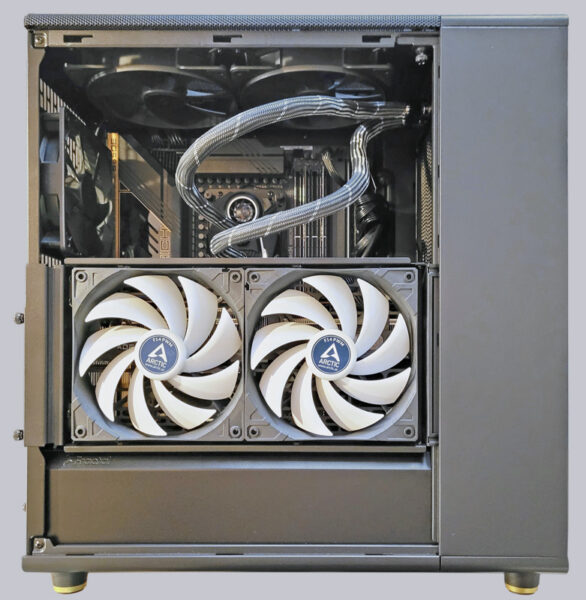
Test setup and results …
The test system with which we determined the following measurements includes the following components …
| Motherboard | ASRock B650E Taichi with M.2 PCIe 4.0 x4 Interface |
| SSD | Crucial P5 Plus 1TB M.2 PCIe 4.0 NVMe-1.4 CT1000P5PSSD8 |
| CPU | AMD Ryzen 5 7600X |
| RAM | 2x 16GB DDR5-5600 from Crucial |
| PSU | Cooler Master V750 Gold |
| Graphics card | AMD Radeon RX6800XT |
| Case | Fractal Design North |
| Cooler | Arctic Liquid Freezer II 360 |
| Operating system | Windows 11 – Version 21H2 |
PWM control …
As announced on the packaging, the P12 Max fans have a 0dB mode, which means that the fans stand still at a PWM setting <5%. This also works flawlessly in practice. At 6% PWM, the P12 Max on our ASRock B650E Taichi motherboard start to rotate permanently at a speed of about 300 rpm, albeit a bit rough. At 10% PWM, the fans then run absolutely smoothly and evenly at around 450rpm. When spinning freely, the P12 Max fans even exceed the manufacturer's specification of a maximum of 3300 rpm a bit and reach a remarkable 3400 rpm in our test. This puts the P12 Max in the highest speed regions of 120mm PC fans that can be found on the market.
Volume …
We determine the volume at a distance of 50cm from the front of the case. This corresponds to a setup with a PC standing on the desk. We regulate the case fans to 30%, because our measurement device does not show any further noise reduction below that, which is the starting point for the volume measurement of the Arctic P12 Max fans. With this measurement method, we can determine the influence of the noise level on the overall system. The following volume data always refers to the entire test system and not to the P12 Max fans alone. Besides the test fans, two 140mm fans and three 120mm fans are installed in the case. The fans of the graphics card and the power supply were not in use during the test.

All case parts were closed during the volume measurements in order to correspond to a practical operation. We determined the following noise levels at different fan speeds with 3 Arctic P12 Max fans in the front of the case on the 360mm radiator, whereby the case fans always ran at 30% PWM.
| PWM | Speed | Volume |
| 15% | 650 rpm | 32dBA |
| 20% | 870 rpm | 33dBA |
| 25% | 1000 rpm | 34dBA |
| 30% | 1250 rpm | 35dBA |
| 40% | 1550 rpm | 37dBA |
| 50% | 1850 rpm | 40dBA |
| 60% | 2100 rpm | 43dBA |
| 70% | 2300 rpm | 46dBA |
| 80% | 2600 rpm | 50dBA* |
| 90% | 2850 rpm | 52dBA |
| 100% | 3050 rpm | 55dBA |
As expected, the P12 Max on a radiator no longer reaches the previously determined maximum free-spinning speed due to the increased flow resistance, but now lands at a still very respectable 3050 rpm. Up to 15% PWM or 650 rpm, Arctic’s three high-performance fans do not stand out noticeably from the overall system’s basic noise level. From 20% to 40% PWM, the P12 Max fans are pleasantly quiet. The flow noise can be perceived as an unobtrusive, even hiss. At the same time, the P12 Max already generate a decent airflow that provides good cooling. For high-performance PCs, the turbo can then be ignited from 50% PWM, because then it goes over the 2000 rpm limit and the noise increases drastically. To drown out the air noise, we recommend a powerful sound system or a headset with over-ear headphones.
Cooling performance …
To determine the cooling performance, we use the Cinebench R23 benchmark to simulate a high utilization of the processor under almost real circumstances without stressing the CPU abnormally high like the Prime 95 Small FFT test would do. The following readings were taken for the CPU temperature with the various fan speeds at a room temperature of 23°C.
| PWM | Speed | CPU Temp. | 15% | 600 rpm | 82°C |
| 20% | 870 rpm | 81°C |
| 25% | 1000 rpm | 80°C |
| 30% | 1250 rpm | 79°C |
| 40% | 1550 rpm | 78°C |
| 50% | 1850 rpm | 77°C |
| 60% | 2100 rpm | 76.5°C |
| 70% | 2300 rpm | 76.5°C |
| 80% | 2600 rpm | 76.5°C |
| 90% | 2850 rpm | 76.5°C |
| 100% | 3050 rpm | 76.5°C |
Cooling our AMD Ryzen 5 7600X processor with PBO overclocking doesn’t really require high-performance fans. Thanks to excellent PWM control, the Arctic P12 Max can easily be dialed down to the point where they allow more than enough air to flow through the 360mm radiator at a barely audible volume to keep the processor in the green temperature range during a Cinebench continuous loop. At a medium speed of 1200 to 1800 rpm, the cooling performance is already easily enough for full-grown gaming CPUs and from 2000 rpm onwards, storms are generated that keep even CPU monsters in check. Due to the low waste heat of our test CPU, no further temperature improvement could be achieved in the high rpm range because the water cannot be cooled down below room temperature. However, processors with more dissipated heat, such as an Intel i9 13900K or AMD Ryzen 9 7950X, would noticeably benefit from the higher fan speed of the P12 Max fans.
Arctic P12 Max Result and general impression …

